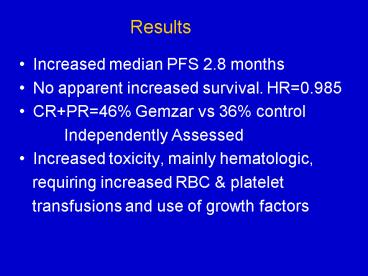Results - PowerPoint PPT Presentation
1 / 18
Title:
Results
Description:
transfusions and use of growth factors. 2004 International ... New Zealand), EORTC (Europe), GEICO (Spain), GINECO (France), NSGO (Scandinavia), JGOG (Japan) ... – PowerPoint PPT presentation
Number of Views:69
Avg rating:3.0/5.0
Title: Results
1
Results
- Increased median PFS 2.8 months
- No apparent increased survival. HR0.985
- CRPR46 Gemzar vs 36 control
- Independently Assessed
- Increased toxicity, mainly hematologic,
- requiring increased RBC platelet
- transfusions and use of growth factors
2
2004 International ConsensusConference on
Ovarian Cancer
3
Gynecological Cancer Intergroup (GCIG)
- GOG (USA), RTOG (USA), NCI-US (USA), NCIC-CTG
(Canada), MRC/NCRI (UK), SGCTG (Scotland),
AGO-OVAR (Germany), ANZGOG (Australia New
Zealand), EORTC (Europe), GEICO (Spain), GINECO
(France), NSGO (Scandinavia), JGOG (Japan)
4
Issue 1Are there regimens that increase
survival in this setting in RCTs ?
- ICON-4 Study Taxol Carboplatin
- Lancet Vol 361 June 21, 2003
- Pegylated Liposomal Doxorubicin
- FDA Review of Doxil SNDA, 2-1-05
- Doxil Package Insert
5
ICON-4 Study Taxol Carboplatin
- Carbo Taxol vs Platinum based CT without
- a Taxane
- Rec/Relapsed Advanced Ovarian Cancer
- after Platinum Based CT
- Platinum Sensitive
- 802 Patients
- HR for Death 0.82, P0.02
- Lancet Vol 361 June 21, 2003
6
Pegylated Liposomal Doxorubicin vs Topotecan
- Advanced Ovarian Cancer
- Recurrent after Platinum Based CT
- Stratified Plat. Sens. vs Plat. Insens.
- 474 Patients
- HR for Death0.82, P0.05
- Plat Sens. Subgroup
- HR for Death 0.7, P0.017
- FDA Review of Doxil SNDA, February
2005 - Doxil Package Insert
7
2004 International ConsensusConference on
Ovarian Cancer
- There is an impact of post recurrence/progressio
n therapy on overall survival (OS). - Annals Oncology 16 (Supplement 8) viii 7-viii
12
8
2004 International ConsensusConference on
Ovarian Cancer
- the unanimous answer is there is an impact
on overall survival. One need look no further
than the ICON4 trial. - Thigpen Ann Oncol 16 (suppl 8) viii 13-viii
19, 2005
9
ISSUE 2Are there regimens that increase
survival in RCTs in the patient population in the
Gemzar RCT setting, if given post progression?
- The FDA knows of no such regimens.
- Probably of interest only if there is imbalance
between treatment groups.
10
Post Study Chemotherapy (PSC)
-
GCb (n178) Cb (n178 - PSC 135
(75.8) 129 (72.5) - No PSC 43
(24.2) 49 (27.5) - PSC Status Known 116
120 -
73 Drug 71 Drug -
43 No Drug 49 No Drug - PCS known in 66.3 of study patients
- 13 (10.8) of Cb patients with Known PCS Status
crossed to Gemzar - 0 GCb patients with Known PSC Status received
Gemzar after prog.
11
Post Study Chemotherapy
- DRUG N Rows Gemzar/ Carbo
-
Carbo - TOPOTECAN 54 31 23
- PLATINUM 45 22 23
- DOXIL 32 16 16
- TAXANE 37 17 20
- ETOPOSIDE 30 21 9
- ALKYLATING AGT. 44 14 28
- ANTHRACYLINE 17 8 9
- GEMCITABINE 13 0 13
- PROVERA 3 0 3
12
Issue 3 Is it likely there would be a Gemzar
survival effect in the Gemzar RCT if it were
expanded?
- HR for death0.985
- Probability of Stat. Sig. Survival increase if
- 177 more deaths were added is
- 0.01 (Cox unstratified) or
- 0.15 (Cox stratified)
13
Issue 4Is improved PFS an adequate basis for
drug approval in this setting?
14
2004 Consensus Conf Ovarian CaFirst-Line CT Adv.
Dis.
- Advanced first-line Both PFS and OS are
- important endpoints to understand the full impact
- of any new treatment. Thus, either may be
- designated as the primary end point. Regardless
- of which is selected, the study should be powered
- so both PFS and OS can be appropriately
- evaluated.
- Annals Oncology 16 (Supplement 8)
viii 7-viii 12
15
2004 Consensus Conf Ovarian CaSecond-Line CT
Adv. Dis.
- Post-recurrence/progression trials The choice
of - the primary end point needs to be fully justified
- with appropriate power calculations. Symptom
- control/quality of life (for early relapse) and
OS (for - late relapse) may be the preferred primary end
- points, although PFS should still be used in the
- assessment of new treatments. Whatever the
- primary end point, the ability of the study
design to - detect important differences in survival should
be - formally addressed.
- Annals Oncology 16 (Supplement 8)
viii 7-viii 12
16
2004 Consensus Conf Ovarian CaSecond-Line CT
Adv. Dis.
- "For phase III trials in the second-line setting,
- progression-free survival does not seem to be a
- good surrogate for survival there are several
- examples where progression-free survival was
- significantly improved, with no survival impact.
It - can be argued that some of these studies were
- underpowered to detect survival improvements
- however, the weight of evidence to consider
- progression-free survival a surrogate for
- survival, and thus a primary end point in the
- second-line setting, is not strong as yet.
17
2004 Consensus Conf Ovarian Ca Second-Line CT
Adv. Dis. (Continued)
- In the recurrent disease setting, overall
survival - remains an important primary end point
- (particularly if more costly or toxic therapy is
being - offered). Progression-free survival data remain
- of interest but are unlikely to be sufficiently
- persuasive to shift practice patterns.
- Furthermore, since the rationale for treating
- patients with relapsed disease is a desire to
- improve symptoms and thus quality of life,
- an adequate measure of these factors would also
18
2004 Consensus Conf Ovarian CaSecond-Line CT
Adv. Dis. (Continued)
- be an appropriate primary end point for
- randomized trials. However, no universally
- and acknowledged and standardized system of
- symptom measurement analysis is readily
- available. GCIG will continue, through its
working - groups, to build a consensus on how meaningful
- improvements in disease-related symptoms can be
- quantified.
- Annals Oncology 16 (Supplement 8) viii20-viii29,
2005































